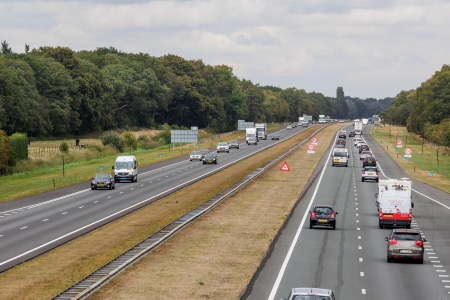The occurrence - and also the outcome - of run-off-road crashes is determined by several factors, and often by a combination of them. We distinguish human factors, infrastructure factors and 'general' factors such as temporary conditions.
Human factors
Human factors concern driver behaviour, fitness to drive and driver state. The following human factors play a role in the occurrence of run-off-road crashes [2] [10] [11] [12] [13] [14] [15] [16] [17]:
- Driving speeds that are too high in the given circumstances;
- fatigue;
- use of alcohol or drugs;
- distraction or inattention;
- incapacitation.
In addition, human factors also play a role in the outcome of run-off-road crashes. We know that a higher driving speed in a collision leads to a higher impact and a higher risk of serious injury (See SWOV fact sheet Speed and speed management). Seatbelt use also proves to be important for the outcome. Of the road deaths among car occupants in run-off-road crashes in the province of Noord-Brabant in 2018-2019, almost half (26 out of 57) were shown not to have used a seatbelt [16]. Of all car occupants, only 4% do not wear seatbelts [18]. Thus, fatality risk is significantly higher when no seatbelt is worn.
Infrastructure factors
Flaws in road and roadside design play a role in both the occurrence and outcome of run-off-road crashes. In-depth studies often reveal the following infrastructure crash factors [2] [3] [11] [12] [13] [14] [15] [16] [17]:
- confined clear zones;
- steep side slopes;
- poorly designed shielding structures;
- too small hard strips or narrow paved shoulders;
- tight curves.
An unshielded obstacle too close to the road is the main infrastructure crash factor. Obstacles include trees, ditches, gantries or guard rails with poorly designed ends[10] [19] [20]. On roads with obstacles close to the road, the risk of a run-off-road crash is estimated to be about twice as high [8] [9]. A too narrow hard strip increases the risk that vehicles that have drifted off the lane will also drift off the road due to less space (and time) to redirect the vehicle and return to the lane.
Another important crash factor is an (unexpectedly) tight curve. The risk of a run-off-road crash increases sharply as a curve become tighter [21] [22]. Furthermore, predictability is also important: an unexpectedly sharp curve makes it more likely that drivers will enter it at too high speed [4] [23].
General factors
(Temporary) conditions such as a wet road surface or darkness may also contribute to the occurrence of run-off-road crashes [4] [5]. Incidentally, the crash factor 'darkness' does not always necessarily contribute to run-off-road crashes in the dark. After all, crashes caused by risky driving behaviour relatively often occur in the dark as well [2].
